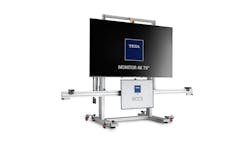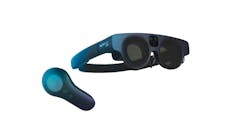This is part two of a two-part article on cracked windshield repair. Read part one here.
If you find yourself with a tiny, or not-so-tiny, crack in your windshield, step one is to determine if you need a repair or a replacement. Next, when you factor in Advanced Driver Assistance Systems, like windshield-mounted cameras, swiftly and properly resolving glass-related issues is paramount.
Because cameras are likely attached to the windshield, repair personnel must also remember that temporarily removing these devices adds a few extra steps to the process.
While still a relatively small share of the overall commercial vehicle market, ADAS has become more common on both medium and heavy-duty trucks over the past few years.
“Nowadays, it’s very important to know how to identify the presence of ADAS in a medium- or heavy-duty vehicle,” said Richard Zenteno, national sales manager for ADAS at Autel North America, a provider of ADAS diagnostic and calibration solutions. “Look for exterior clues, such as a camera mounted on a windshield or beneath the side mirrors. You may also see lights on the side mirrors designed to alert drivers. Then there are interior clues, such as lights on the dashboard showing safety features like lane departure.”
Related content: All-makes ADAS tools help shops keep up with increased technology
Then it’s important to recognize when an ADAS feature needs to be calibrated. There are a couple of windshield-related instances where ADAS calibration would need to be performed: when the windshield is replaced and when any repairable damage could interfere with a camera’s ability to see.
“I would say that for damage within a few inches of the camera, it’s a good idea to do an ADAS calibration once the repair is completed,” said Fabio Mazzon, technical manager at TEXA USA, a provider of ADAS diagnostic and calibration solutions.
There are a couple of reasons why. First and foremost is the safety of the vehicle, which leads to the second reason. “Insurance companies typically want proof that the ADAS calibration was done properly after replacing or repairing a windshield,” Mazzon said.
There are two ways a technician can go about calibrating an ADAS windshield or side mirror. Each has their pros and cons.
Mazzon said the most common method is what is referred to as a dynamic calibration. This is where the calibration takes place while the vehicle is being test driven. In this scenario, the technician may need a CDL if the type of vehicle being serviced requires one.
The other method is known as static calibration. This is where the technician performs the calibration with the vehicle parked, typically in a shop. Mazzon said one consideration is space because the technician needs to set up targets in order to calibrate the camera. The shop will also need to invest in those physical targets, along with any necessary fixtures and other accessories to make them work.
Zenteno said ADAS manufacturer instructions for performing a static calibration can sometimes be confusing, which inevitably adds time to the process. That is why Autel designed its ADAS CV calibration hardware so the technician can set up the target in a matter of minutes.
“We’ve focused on making it fast to set up for multiple manufacturers,” Zenteno said. “That comes down to being able to set up the distance quickly, centering the target and crossbar quickly, and also squaring the crossbar quickly.”
Another popular solution for static calibrations is the TEXA RCCS 3 ADAS calibration frame. It is offered in two versions, one with a 75-inch digital monitor and the other with panel targets. One advantage of the monitor is that the shop doesn’t need to have numerous panels on hand in order to calibrate different types of vehicles and ADAS sensors. All of those different types of panels can be displayed digitally on the monitor.
A good diagnostic scan tool is also a must. Mazzon said a good one will guide the technician through the calibration process with an intuitive user interface.
Thomas Patterson, director of new product development and technical training for Glass Doctor, which specializes in glass repair and replacement services, said Glass Doctor shops throughout the country use a variety of ADAS calibration tools. Each has their pros, cons, and limitations.
“Most of the tools out there will get the job done today,” Patterson said. “But one thing we look at, because this is a significant investment, is what the manufacturer is doing to improve their technology for the future. ADAS calibration has only come on over the past six or seven years, so it’s still fairly new. But the technology is changing fast. We want a diagnostic tool and ADAS calibration system that stays on pace with any new developments.”
Regardless of which calibration solution a shop has, the ADAS manufacturer dictates which calibration method should be used. Sometimes, it’s a combination of both static and dynamic. Whatever the case, Patterson said it’s critical that the technician actually performs the calibration correctly. It is possible to perform a calibration to the system’s bare minimums, which might allow it to “pass” and not throw any fault codes. Thus, Patterson said some technicians just put the camera back on after the windshield is replaced, scan the vehicle, see that there aren’t any fault codes, and assume everything is fine. “It is critical that the proper calibration procedure be followed,” Patterson reminded.





